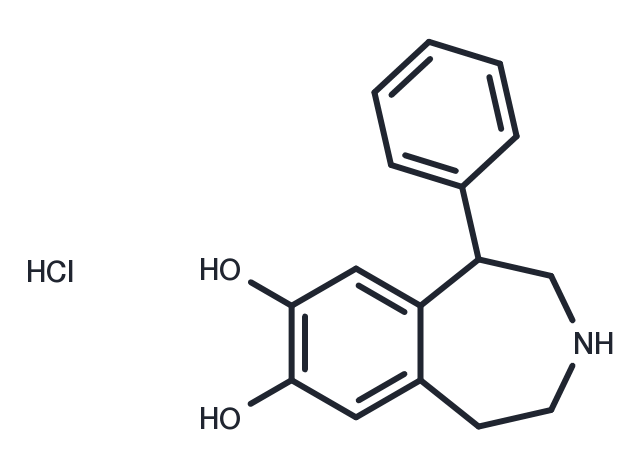Powder: -20°C for 3 years | In solvent: -80°C for 1 year


SKF 38393 hydrochloride (SKF38393 HCl) is a selective dopamine D1/D5 receptor agonist.

| Pack Size | Availability | Price/USD | Quantity |
|---|---|---|---|
| 25 mg | In stock | $ 50.00 | |
| 50 mg | In stock | $ 71.00 | |
| 1 mL * 10 mM (in DMSO) | In stock | $ 78.00 |




| Description | SKF 38393 hydrochloride (SKF38393 HCl) is a selective dopamine D1/D5 receptor agonist. |
| Targets&IC50 | D1:110 nM |
| In vitro | SKF38393 (50-100 μM) induces long-lasting synaptic potentiation in a protein synthesis-dependent manner. [1] In rat prefrontal cortical neurons in vitro, SKF 38393 mimicks the effects of DA on I(NaP), and modulates a persistent sodium current. [2] In the auditory cortex, SKF38393 affects long-term memory formation and consolidation by activating the downstream effectors adenylyl cyclase and phospholipase C-prominent proteomic alterations. [4] |
| In vivo | SKF 38393(6 mg/kg, i.p.) prevents the scopolamine-induced impairment of performance of a T-maze working memory task. [3] In adult male NMRI mice, SKF38393 (1 μg/mouse) impaires context-dependent fear learning. [5] |
| Synonyms | (±)-SKF-38393 hydrochloride, SKF-38393A, SKF38393 HCl |
| Molecular Weight | 291.77 |
| Formula | C16H17NO2·HCl |
| CAS No. | 62717-42-4 |
Powder: -20°C for 3 years | In solvent: -80°C for 1 year
Ethanol: 6 mg/mL(20.56 mM), Heating is recommended.
H2O: < 1 mg/mL (insoluble or slightly soluble)
DMSO: 54 mg/mL (185.1 mM)
You can also refer to dose conversion for different animals. More
bottom
Please see Inhibitor Handling Instructions for more frequently ask questions. Topics include: how to prepare stock solutions, how to store products, and cautions on cell-based assays & animal experiments, etc.
SKF 38393 hydrochloride 62717-42-4 GPCR/G Protein Neuroscience Dopamine Receptor SKF 38393 Hydrochloride SKF 38393 SKF-38393 inhibit Inhibitor SKF38393 (±)-SKF-38393 hydrochloride SKF-38393A SKF38393 Hydrochloride SKF-38393 Hydrochloride SKF38393 HCl inhibitor
